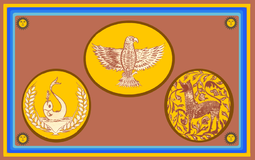 | |
| Use | Civil and state flag |
|---|---|
| Proportion | 2:3 |
| Adopted | 22 May 2007 |
| Design | An eagle, a fish and a lion on circular backgrounds representing the three districts of the province, bordered by a series of blue and yellow lines on a brown background, with a sun in each corner. |
The flag of Eastern Province, was adopted for the Eastern Province of Sri Lanka on 22 May 2007. [1] [2]